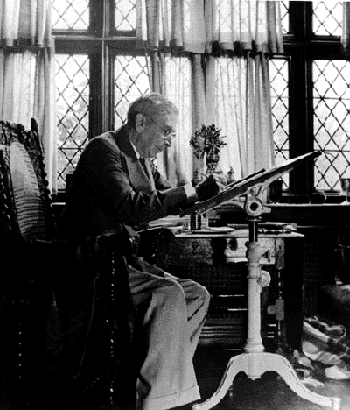

AN INDIANAPOLIS CHILDHOOD
Newton Booth Tarkington lived with his family in comfortable middle-class surroundings in Indianapolis. The Panic of 1873 disrupted the family's comfort, and for the next three years the Tarkingtons rented houses in less fashionable neighborhoods. With fortunes improving, thanks to a gift from Booth's namesake, Uncle Newton Booth, the family moved into a new house at 1100 N. Pennsylvania St. The Indianapolis locale and middle-class milieu Tarkington knew so well from his youth served him well in his writings.
SCHOOL DAZE
"No doubt I imbibed some education there, though it seems to me that I tried to avoid that as much as possible."
Following a nine-week stint of truancy from Shortridge High School, Tarkington's parents sent the errant student to Phillips Exeter Academy. Booth did not, however, improve as a pupil. He wrote in an autobiographical piece that he "had no consciousness of any hour but the present; whatever was idiotic engrossed me." Returning to Indiana, he spent two years at Purdue University. After Purdue, Tarkington attended Princeton University. Although he never graduated, he held a special place in his heart for the Ivy League school.
A LIVING FROM DRAWING AND WRITING
"Booth, I asked your father what you're doing. He says you're still trying to be one of these damn literary fellers."
In 1893 Tarkington returned to Indianapolis and tried to make a living from drawing and writing. Following the sale of a sketch with text to Life magazine in 1895, for which he received $20, Tarkington collected 31 consecutive rejection slips from popular magazines of the 1890s, such as Century, Harper's, McClure's and Scribner's. Reminiscing about those early failures, Tarkington felt that his manuscripts were rejected so rapidly that the "poor things must have been stopped and returned from Philadelphia; they didn't seem to have time to get all the way to New York and back."
HE IS A NOVELIST
In the fall of 1898, after a five-year break from the manuscript, Tarkington finished The Gentleman from Indiana. Later that year, without his knowledge, his sister Haute while in New York showed publisher S. S. McClure her brother's Monsieur Beaucaire manuscript. McClure was not interested. He was, however, interested in the story about Indiana that Haute mentioned. She urged Tarkington to send the manuscript to McClure. Two weeks after he sent it Tarkington received a letter from American novelist Hamlin Garland. It opened with the words Tarkington had waited years to read: "Mr. McClure has given me your manuscript, The Gentleman from Indiana, to read. You are a novelist."
A POLITICAL LIFE
"We voted for him as sort of an experiment, the paper said he's a play writer and some kind of an actor, and we just want to see what sort of gosh derned fool he'll make of himself in the Legislature."
Tarkington felt that it was the duty of good citizens to run for public office. Accordingly, on March 14, 1902, Tarkington filed as a candidate for state representative. He easily secured a place on the November ballot as one of seven Republican candidates and won in the fall election. This closer look at politics gave Tarkington background for In the Arena: Stories of Political Life. As they appeared serially, the stories gained favor with President Theodore Roosevelt, who invited Tarkington to lunch at the White House in 1904.
THE WRITING YEARS
With the publication of Gentleman from Indiana, a best-seller in 1900, Tarkington's literary career was launched. He went on to write a number of popular novels over the years, and he twice won the Pulitzer Prize--for The Magnificent Ambersons and Alice Adams. Booksellers rated Tarkington number one in a 1921 Publishers Weekly poll of significant contemporary American authors, rating him above the likes of Edith Wharton, Sinclair Lewis, Robert Frost and Carl Sandburg.
A HOOSIER AT HEART
Although Tarkington traveled throughout Europe and North America, and eventually built an estate, Seawood, in Kennebunkport, Maine, he always maintained a fondness for Indiana. He and his wife, Susannah Robinson, lived in Seawood from May through December and returned to Indiana for the rest of year. Despite failing eyesight and a heart condition, the 1930s and 1940s were busy years for Tarkington. He continued to write novels and short stories and enjoyed entertaining friends in the evening. Following a two-month illness, Tarkington died at his Indianapolis home on May 19, 1946.
 Return to IHS home page, Golden Age, or Hoosier Heritage.
Return to IHS home page, Golden Age, or Hoosier Heritage.